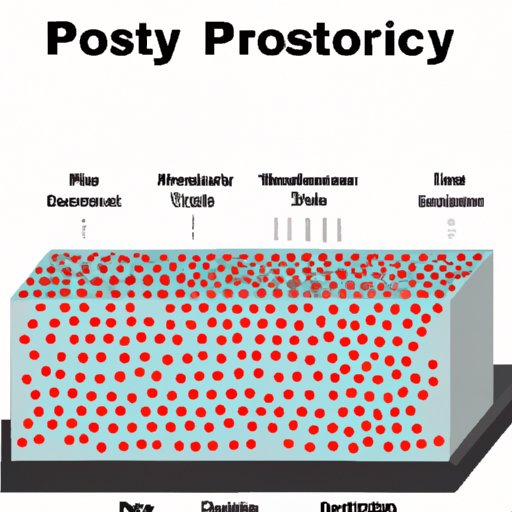Introduction
Porosity is a term used to describe the amount of empty space or voids within a material. It is a fundamental property of materials that has far-reaching implications for many scientific disciplines, including geology, hydrology, engineering, and environmental sciences. In this article, we will explore what porosity is, the different types of porosity, and how it impacts scientific research and the environment.
Exploring Porosity: What is it and How Does it Affect Science?
Porosity can be defined as the ratio of the volume of empty spaces in a material to the total volume of the material. It is expressed as a percentage and is typically measured by determining the void volume or the open porosity. Porosity is an important factor in determining the physical properties of a material, such as permeability, compressibility, and strength. The presence of pores also affects the chemical and biological processes that take place within a material.
There are several different types of porosity that can be found in materials. Vuggy porosity refers to large, interconnected voids, while intergranular porosity occurs between solid particles. Fracture porosity is created by fractures in the material, and solution porosity is caused by chemical dissolution. Each type of porosity affects the physical and chemical properties of a material differently.
The porosity of a material also plays an important role in scientific research. Porosity is used to determine the permeability of a material, which is important for understanding the flow of fluids through rocks and soils. Porosity also affects the compressibility of a material, which is important for understanding how materials deform under stress. Finally, porosity is used to measure the strength of a material, which is important for designing structures and predicting their performance.

A Comprehensive Guide to Porosity in Science
In order to understand the role of porosity in scientific research, it is important to have a thorough understanding of its definition and uses. Porosity is typically measured using a variety of techniques, such as mercury intrusion porosimetry, helium pycnometry, and image analysis. These techniques allow scientists to accurately measure the porosity of a material and determine its physical properties.
Once the porosity of a material has been determined, it can then be used to analyze data collected from experiments. For example, porosity measurements can be used to study the behavior of fluids in porous media, such as groundwater flow or oil production. Porosity measurements can also be used to evaluate the strength of a material, such as concrete or steel, or to assess the compressibility of soils.

Unpacking Porosity: What Scientists Need to Know
When studying porosity in scientific research, it is important to understand the basics of what it is and how it is measured. Porosity is typically measured using a variety of techniques, such as mercury intrusion porosimetry, helium pycnometry, and image analysis. These techniques allow scientists to accurately measure the porosity of a material and determine its physical properties.
Once the porosity of a material has been determined, it can then be used to analyze data collected from experiments. For example, porosity measurements can be used to study the behavior of fluids in porous media, such as groundwater flow or oil production. Porosity measurements can also be used to evaluate the strength of a material, such as concrete or steel, or to assess the compressibility of soils.
Uncovering the Mysteries of Porosity in Science
Porosity is an essential component of many scientific disciplines, and its effects on materials can be quite complex. Porosity affects the physical properties of materials, such as permeability and compressibility, as well as the chemical processes that take place within them. Porosity can also influence the behavior of biological systems, such as the movement of nutrients and waste products within soil.
Understanding the effect of porosity on materials can be challenging. To truly comprehend the importance of porosity in scientific research, it is necessary to examine its effects on the physical properties of materials, its influence on chemical processes, and its role in biological systems. By doing so, researchers can gain a deeper understanding of porosity and its relevance to science.

Porosity: Its Role in Science and its Impact on the Environment
The porosity of a material has a significant impact on our natural world. Porosity affects the permeability of soils and rocks, which can have a major effect on water flow and the availability of groundwater. Porosity also affects the compressibility of soils, which can have an impact on the stability of structures built on them. Finally, porosity can affect the movement of pollutants in the environment, which can have profound implications for human health.
Identifying ways to mitigate the environmental impacts of porosity is an important research area. Scientists are exploring ways to alter the porosity of materials to reduce their permeability, compressibility, and pollutant transport. By understanding the effect of porosity on the environment, scientists can develop strategies to reduce its negative impacts.
Recent advances in porosity research are also providing new insights into the role of porosity in scientific research. Researchers are developing new techniques to measure porosity more accurately, as well as new methods to analyze the data collected from porosity measurements. With these new tools, scientists can gain a better understanding of the role of porosity in materials and its impact on the environment.
Conclusion
Porosity is an essential property of materials that has far-reaching implications for scientific research and the environment. By understanding what porosity is, the different types of porosity, and how it affects scientific research, scientists can gain a better understanding of this important concept. With new advances in porosity research, scientists can identify ways to mitigate the environmental impacts of porosity and uncover the mysteries of this fascinating property.
(Note: Is this article not meeting your expectations? Do you have knowledge or insights to share? Unlock new opportunities and expand your reach by joining our authors team. Click Registration to join us and share your expertise with our readers.)
